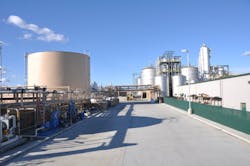SunPower, Schneider supplying Solar-Battery Storage for AI-driven Microgrid at Aemetis Biorefinery
Biofuels firm Aemetis will utilize a solar and battery storage microgrid to strengthen power resiliency at its Advanced Fuels biorefinery in Keyes, California.
SunPower and Schneider Electric were selected to provide components for the grid-connected microgrid featuring nearly 2 MW of solar photovoltaic panels and a 1.25-MW battery energy storage system.
The microgrid will be integrated with an artificial intelligence (AI)-driven distributed control system at the Keyes biorefinery. Overall, Aemetis predicted, the solar-storage microgrid will reduce greenhouse gas emissions by about 8,000 metric tons per year.
The microgrid offers resiliency in case of grid outages and also can assist with off peak shaving and energy efficiency at the Advanced Fuels ethanol and renewable natural gas upgrading and injection facility in Keyes.
The $12 million solar microgrid, battery backup and AI-enabled energy system is supported by an $8 million grant awarded to Aemetis by the California Energy Commission.
“At a time when the transportation industry is driving to meet sustainability goals and reduce emissions, solar continues to become a bigger part of our daily lives with innovative solutions that help improve our air quality,” said Eric Potts, Executive Vice President for Commercial at SunPower. “SunPower is proud to work with Aemetis to utilize the state’s Low Carbon Fuel Standard, which drives renewable options for their operations and is helping the transportation sector decarbonize across the west. We applaud Aemetis for their leadership and leveraging the power of the sun.”
The solar array will generate approximately 3.2 million kWh per year. In addition to designing and supplying the photovoltaic solar system, SunPower will serve as the project’s engineering, procurement, and construction (EPC) contractor.
The new AI-enabled control system will run on virtualized servers, reducing the amount of computer hardware by 80%, which will require less power to operate than traditional systems. Virtualized systems do not require changing hardware to upgrade obsolescent operating systems or security changes. The virtual environment will also help reduce planned and unplanned down time.
-- -- --
(Rod Walton, senior editor for EnergyTech, is a 14-year veteran of covering the energy industry both as a newspaper and trade journalist. He can reached at [email protected]).
About the Author
Rod Walton, EnergyTech Managing Editor
Managing Editor
For EnergyTech editorial inquiries, please contact Managing Editor Rod Walton at [email protected].
Rod Walton has spent 17 years covering the energy industry as a newspaper and trade journalist. He formerly was energy writer and business editor at the Tulsa World. Later, he spent six years covering the electricity power sector for Pennwell and Clarion Events. He joined Endeavor and EnergyTech in November 2021.
Walton earned his Bachelors degree in journalism from the University of Oklahoma. His career stops include the Moore American, Bartlesville Examiner-Enterprise, Wagoner Tribune and Tulsa World.
EnergyTech is focused on the mission critical and large-scale energy users and their sustainability and resiliency goals. These include the commercial and industrial sectors, as well as the military, universities, data centers and microgrids. The C&I sectors together account for close to 30 percent of greenhouse gas emissions in the U.S.
He was named Managing Editor for Microgrid Knowledge and EnergyTech starting July 1, 2023
Many large-scale energy users such as Fortune 500 companies, and mission-critical users such as military bases, universities, healthcare facilities, public safety and data centers, shifting their energy priorities to reach net-zero carbon goals within the coming decades. These include plans for renewable energy power purchase agreements, but also on-site resiliency projects such as microgrids, combined heat and power, rooftop solar, energy storage, digitalization and building efficiency upgrades.

